2016广东技术师范学院F126英语教学论复试大纲
- 格式:pdf
- 大小:104.73 KB
- 文档页数:1
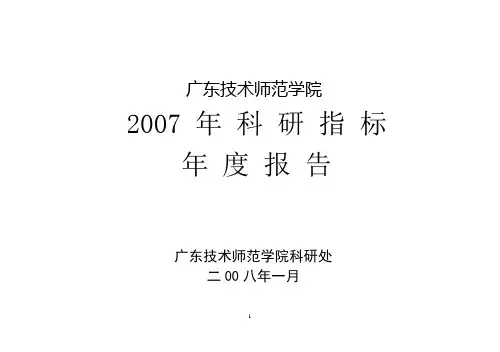
广东技术师范学院2007 年科研指标年度报告广东技术师范学院科研处二00八年一月1目录一、学术著作与教材 (1)二、学术论文 (6)2.1 计算机学院 (7)2.2 电子与信息学院 (14)2.3 教育技术与传播学院 (20)2.4 自动化学院 (23)2.5 机电学院 (25)2.6 工业实训中心 (29)2.7 计算机与网络中心 (32)2.8 文学院 (35)2.9 会计学院 (44)2.10 管理学院 (49)2.11 外国语学院 (58)2.12 美术学院 (61)2.13 政法学院 (65)2.14 经济与贸易学院 (69)2.15 教育学院 (73)2.16 民族学院 (77)2.17 社会科学部 (80)2.18 大学英语教学部 (83)2.19 体育教学部 (86)2.20 图书馆 (89)2.21 学报编辑部 (92)2.22 党政机关 (96)2三、学术会议论文 (106)四、科研项目 (118)3一、学术著作与教材12345二、学术论文62.1 计算机学院789101112注:排序项中不写数字为第一排序132.2 电子与信息学院1415161718注:排序项中不写数字为第一排序192.3 教育技术与传播学院2021注:排序项中不写数字为第一排序222.4 自动化学院23注:排序项中不写数字为第一排序242.5 机电学院252627注:排序项中不写数字为第一排序282.6 工业实训中心29注:排序项中不写数字为第一排序312.7 计算机与网络中心3233注:排序项中不写数字为第一排序342.8 文学院3536373839404142注:排序项中不写数字为第一排序432.9 会计学院44454647。
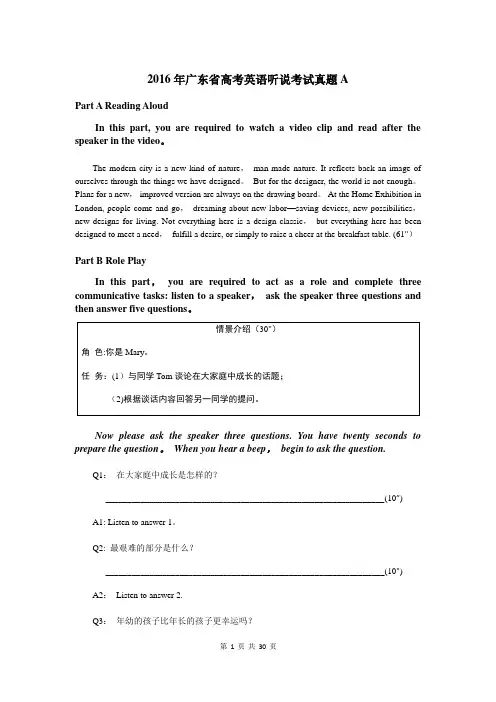
2016年广东省高考英语听说考试真题APart A Reading AloudIn this part, you are required to watch a video clip and read after the speaker in the video。
The modern city is a new kind of nature,man-made nature. It reflects back an image of ourselves through the things we have designed。
But for the designer, the world is not enough。
Plans for a new,improved version are always on the drawing board。
At the Home Exhibition in London, people come and go,dreaming about new labor—saving devices, new possibilities,new designs for living. Not everything here is a design classic,but everything here has been designed to meet a need,fulfill a desire, or simply to raise a cheer at the breakfast table. (61")Part B Role PlayIn this part,you are required to act as a role and complete three communicative tasks: listen to a speaker,ask the speaker three questions and then answer five questions。
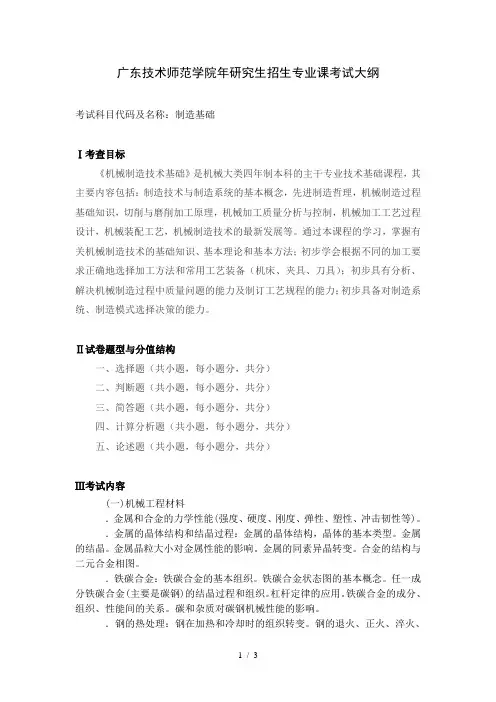
广东技术师范学院年研究生招生专业课考试大纲考试科目代码及名称:制造基础Ⅰ考查目标《机械制造技术基础》是机械大类四年制本科的主干专业技术基础课程,其主要内容包括:制造技术与制造系统的基本概念,先进制造哲理,机械制造过程基础知识,切削与磨削加工原理,机械加工质量分析与控制,机械加工工艺过程设计,机械装配工艺,机械制造技术的最新发展等。
通过本课程的学习,掌握有关机械制造技术的基础知识、基本理论和基本方法;初步学会根据不同的加工要求正确地选择加工方法和常用工艺装备(机床、夹具、刀具);初步具有分析、解决机械制造过程中质量问题的能力及制订工艺规程的能力;初步具备对制造系统、制造模式选择决策的能力。
Ⅱ试卷题型与分值结构一、选择题(共小题,每小题分,共分)二、判断题(共小题,每小题分,共分)三、简答题(共小题,每小题分,共分)四、计算分析题(共小题,每小题分,共分)五、论述题(共小题,每小题分,共分)Ⅲ考试内容(一)机械工程材料.金属和合金的力学性能(强度、硬度、刚度、弹性、塑性、冲击韧性等)。
.金属的晶体结构和结晶过程:金属的晶体结构,晶体的基本类型。
金属的结晶。
金属晶粒大小对金属性能的影响。
金属的同素异晶转变。
合金的结构与二元合金相图。
.铁碳合金:铁碳合金的基本组织。
铁碳合金状态图的基本概念。
任一成分铁碳合金(主要是碳钢)的结晶过程和组织。
杠杆定律的应用。
铁碳合金的成分、组织、性能间的关系。
碳和杂质对碳钢机械性能的影响。
.钢的热处理:钢在加热和冷却时的组织转变。
钢的退火、正火、淬火、回火、表面处理等热处理方法的实质、工艺特点和应用范围。
.常用金属材料的分类、编号、热处理特点和应用(碳钢、铸铁、合金钢、铜合金、铝合金)。
.非金属材料:常用高分子材料的种类、特性、成形方法、选用原则。
陶瓷、复合材料的基本知识。
(二)铸造.铸造的基本概念和工艺特点:基本造型方法的分析比较。
铸造生产的工艺过程和工艺特点。
铸造工艺方案的基本内容。
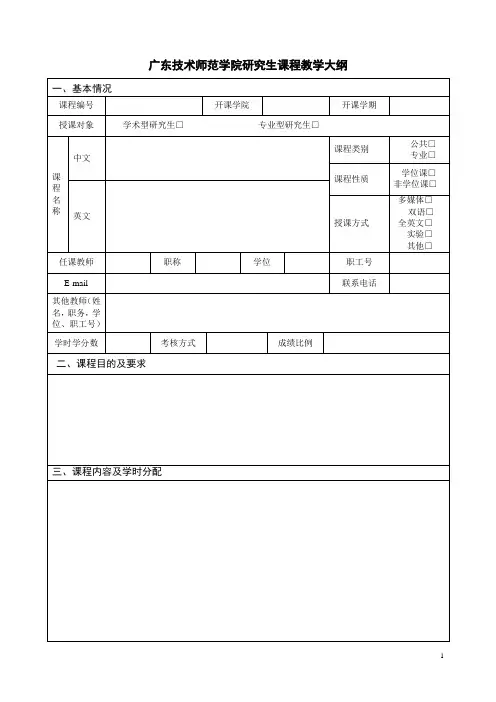
广东技术师范学院研究生课程教学大纲
编写人:时间:
教学大纲填写说明
一、填表范围
所有专业开设的课程(理论课程、实验课程),均必须填写课程教学大纲。
二、填写要求
1、所有表格内容请用五号宋体填写。
2、表格中所有内容必须填写。
3、教学大纲需用A4纸正反打印。
三、具体填表项目说明
1、课程编码:由教学秘书按照“按照研究生教务系统”自动生成的填写。
2、开课学院:请填写学院的全称,如:教育科学与技术学院。
3、开课学期:请填写阿拉伯数字,如:第2学期。
4、授课方式:可以多选。
5、任课教师:课程可以由多名副教授以上(或博士毕业讲师3年以上)教师组成。
6、学时学分数:按照以下方式填写,如18学时/1学分。
7、考核方式:具体包括闭卷、开卷、论文(报告)、课程设计、其他。
8、成绩比例:按照以下方式填写,如:平时成绩30%,期中成绩20%,期末成绩50%。
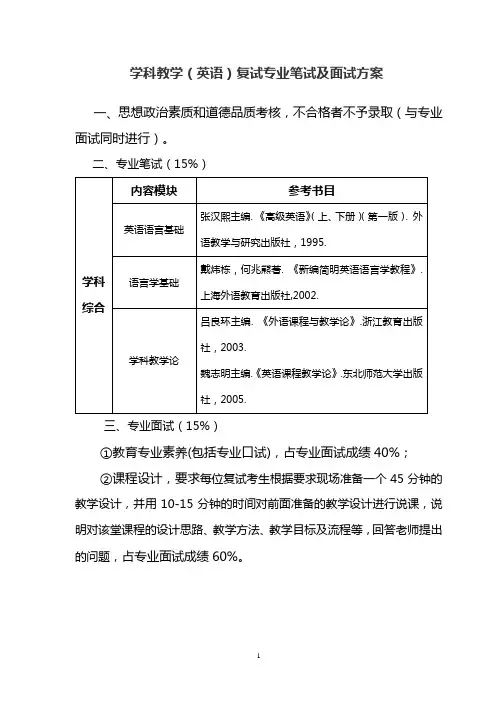
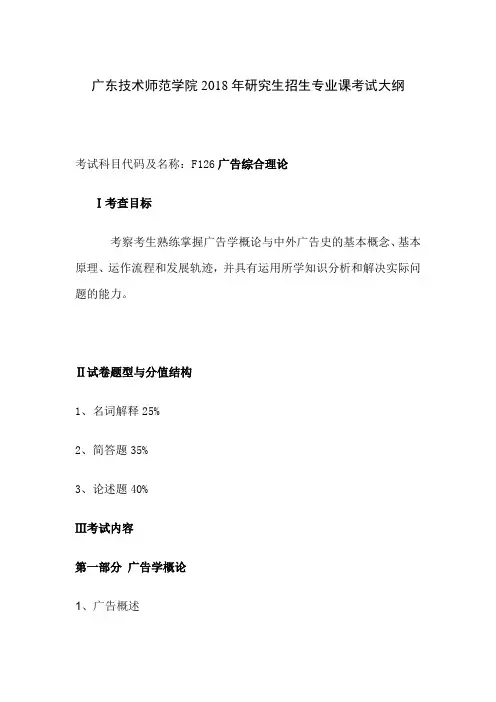
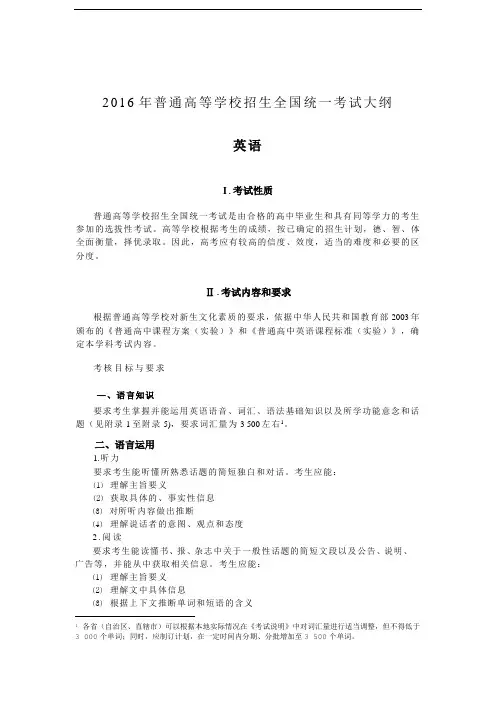
2016年普通高等学校招生全国统一考试大纲英语I.考试性质普通高等学校招生全国统一考试是由合格的高中毕业生和具有同等学力的考生参加的选拔性考试。
高等学校根据考生的成绩,按已确定的招生计划,德、智、体全面衡量,择优录取。
因此,高考应有较高的信度、效度,适当的难度和必要的区分度。
Ⅱ.考试内容和要求根据普通高等学校对新生文化素质的要求,依据中华人民共和国教育部2003年颁布的《普通高中课程方案(实验)》和《普通高中英语课程标准(实验)》,确定本学科考试内容。
考核目标与要求—、语言知识要求考生掌握并能运用英语语音、词汇、语法基础知识以及所学功能意念和话题(见附录1至附录5),要求词汇量为3 500左右1。
二、语言运用1.听力要求考生能听懂所熟悉话题的简短独白和对话。
考生应能:(1)理解主旨要义(2)获取具体的、事实性信息(3)对所听内容做出推断(4)理解说话者的意图、观点和态度2.阅读要求考生能读懂书、报、杂志中关于一般性话题的简短文段以及公告、说明、广告等,并能从中获取相关信息。
考生应能:(1)理解主旨要义(2)理解文中具体信息(3)根据上下文推断单词和短语的含义1各省(自治区、直辖市)可以根据本地实际情况在《考试说明》中对词汇量进行适当调整,但不得低于3 000个单词;同时,应制订计划,在一定时间内分期、分批增加至3 500个单词。
(4)做出判断和推理(5)理解文章的基本结构(6)理解作者的意图、观点和态度3.写作要求考生根据提示进行书面表达。
考生应能:(1)清楚、连贯地传递信息,表达意思(2)有效运用所学语言知识4.口语要求考生根据提示进行口头表达。
考生应能:(1)询问或传递事实性信息,表达意思和想法(2)做到语音、语调自然(3)做到语言运用得体(4)使用有效的交际策略附录1 语音项目表1.基本读音(1)26个字母的读音(2)元音字母在重读音节中的读音(3)元音字母在轻读音节中的读音(4)元音字母组合在重读音节中的读音(5)常见的元音字母组合在轻读音节中的读音(6)辅音字母组合的读音(7)辅音连缀的读音(8)成节音的读音2.重音(1)单词重音(2)句子重音3.读音的变化(1)连读(2)失去爆破(3)弱读(4)同化4.语调与节奏(1)意群与停顿(2)语调(3)节奏5.语音、语调、重音、节奏等在口语交流中的运用6.朗诵和演讲中的语音技巧7.主要英语国家的英语语音差异附录2 语法项目表1.名词(1)可数名词及其单复数(2)不可数名词(3)专有名词(4)名词所有格2.代词(1)人称代词(2)物主代词(3)反身代词(4)指示代词(5)不定代词(6)疑问代词3.数词(1)基数词(2)序数词4.介词和介词短语5.连词6.形容词(比较级和最高级)7.副词(比较级和最高级)8.冠词9.动词(1)动词的基本形式(2)系动词(3)及物动词和不及物动词(4)助动词(5)情态动词10.时态(1)一般现在时(2)一般过去时(3)一般将来时(4)现在进行时(5)过去进行时(6)过去将来时(7)将来进行时(8)现在完成时(9)过去完成时(10)现在完成进行时11.被动语态12.非谓语动词(1)动词不定式(2)动词的-ing形式(3)动词的-e d形式13.构词法(1)合成法(2)派生法(3)转化法(4)缩写和简写14.句子种类(1)陈述句(2)疑问句(3)祈使句(4)感叹句15.句子成分(1)主语(2)谓语(3)表语(4)宾语(5)定语(6)状语(7)补语16.简单句的基本句型17.主谓一致18.并列复合句19.主从复合句(1)宾语从句(2)状语从句(3)定语从句(4)主语从句(5)表语从句20.间接引语21.省略22.倒装23.强调24.虚拟语气附录3 功能意念项目表1.社会交往(Social Communications)(1)问候(Greetings)(2)介绍(Introduction)(3)告别(Farewells)(4)感谢(Thanks)(5)道歉(Apologies)(6)邀请(Invitation)(7)请求允许(Asking for permission)(8)祝愿和祝贺(Expressing wishes and congratulations) (9)提供帮助(Offering help)(10)接受和拒绝(Acceptance and refusal)(11)约会(Making appointments )(12)打电话(Making telephone calls)(13)就餐(Having meals)(14)就医(Seeing the doctor)(15)购物(Shopping)(16)问路(Asking the way)(17)谈论天气(Talking about weather)(18)语言交际困难(Language difficulties in communication) (19)提醒注意(Reminding)(20)警告和禁止(Warning and prohibition)(21)劝告(Advice)(22)建议(Suggestions)2.态度(Attitudes)(23)同意和不同意(Agreement and disagreement)(24)喜欢和不喜欢(Likes and dislikes)(25)肯定和不肯定(Certainty and uncertainty)(26)可能和不可能(Possibility and impossibility)(27)能够和不能够(Ability and inability )(28)偏爱和优先选择(Preference)(29)意愿和打算(Intentions and plans)(30)希望和愿望(Hopes and wishes)(31)表扬和鼓励(Praise and encouragement) (32)责备和抱怨(Blame and complaint)(33)冷淡(Indifference)(34)判断与评价(Judgement and evaluation)3. 情感(Emotions)(35)高兴(Happiness)(36)惊奇(Surprise)(37)忧虑(Worries)(38)安慰(Reassurance)(39)满意(Satisfaction)(40)遗憾(Regret)(41)同情(Sympathy)(42)恐惧(Fear)(43)愤怒(Anger)4. 时间(Time)(44)时刻(Point of time)(45)时段(Duration)(46)频度(Frequency)(47)时序(Sequence)5. 空间(Space)(48)位置(Position)(49)方向(Direction)(50)距离(Distance)6. 存在(Existence)(51)存在与不存在(Existence and Non-existence) 7.特征(Features)(52)形状(Shape)(53)颜色(Colour)(54)材料(Material)(55)价格(Price)(56)规格(Size)(57)年龄(Age)8.计量(Measurement)(58)长度(Length)(59)宽度(Width)(60)高度(Height)(61)数量(Number)9.比较(Comparison)(62)同级比较(Equal comparison)(63)差别比较(Comparative and superlative)(64)相似和差别(Similarity and difference)10.逻辑关系(Logical relations)(65)原因和结果(Cause and effect)(66)目的(Purpose)11.职业(Occupations)(67)工作(Jobs)(68)单位(Employer)附录4话题项目表1.个人情况(Personal information)2.家庭、朋友与周围的人(Family,friends and people around)3.周围的环境(Personal environments)4.日常活动(Daily routines)5.学校生活(School life)6.兴趣与爱好(Interests and hobbies)7.个人感情(Emotions)8.人际关系(Interpersonal relationships)9.计划与愿望(Plans and intentions)10.节假日活动(Festivals, holidays and celebrations)11.购物(Shopping)12.饮食(Food and drink)13.健康(Health)14.天气(Weather)15.文娱与体育(Entertainment and sports)16.旅游和交通(Travel and transport)17.语言学习(Language learning)18.自然(Nature)19.世界与环境(The world and the environment)20.科普知识与现代技术(Popular science and modern technology)21.热点话题(Topical issues)22.历史与地理(History and geography)23.社会(Society)文学与艺术(Literature and art)附录5 词汇表Aa(an)artabandon vability nable aabnormal aaboard prepabolish vabortion nabout ad & prepabove prep, a & adabroad ad abrupt a absence n absent a absolute a absorb v abstract a & n absurd a abundant a abuse v academic a & n academy n accelerate v accent naccept vaccess n & v accessible a accident n accommodation n accompany v accomplish v account n accountant n accumulate v accuracy n accurate a accuse v accustomed a ache v & n achieve v achievement n acid aacknowledge v acquaintance n acquire v acquisition nacre nacross prepact n & vaction nactive aactivity nactor nactress nactual aacute aAD abbrad=advertisement n adapt v adaptation nadd vaddicted a addition n address n adequate aadjust v adjustment n administration n admirable a admire v admission nadmit v adolescence n adolescent a & nadopt vadore vadult nadvance v & n advantage n adventure n advertise v advertisement n advice nadvise vadvocate vaffair naffect vaffection nafford vafraid aAfrica nAfrican a & nafter ad, prep & conj afternoon n afterward(s)ad again adagainst prepage nagency nagenda nagent n aggressive aago adagree v agreement n agricultural aagriculture n ahead adaid n & v AIDS naim n & vair naircraft n airline n airmail n airplane n airport n airspace n alarm n & v album n alcohol n alcoholic a & n algebra nalike adalive aall ad, a & pron allergic aalley n allocate v allow v allowance n almost ad alone aalong ad & prep alongside ad aloud ad alphabet n already adalso adalternative aalthough conjaltitude naltogether ad aluminium(Am aluminum)n always adam v(be)a.m./am, A.M./AM abbr amateur aamaze vamazing a ambassador n ambassadress n ambiguous aambition n ambulance nAmerica namong prepamount n & vample aamuse vamusement nanalyse vanalysis nancestor nanchor v & nancient aand conjanecdote nanger nangle nangry aanimal nankle n anniversary n announce v annoy vannual a another a & pron answer n & v ant nAntarctic a antique n anxiety n anxious aany pron & a anybody pron anyhow ad anyone pron anything pron anyway ad anywhere ad apart ad & a apartment n apologize v apology n apparent a appeal v & n appear v appearance n appendix n appetite napplaud v & n apple napplicant n application napply vappoint v appointment n appreciate v appreciation n approach n & v appropriate a approval n approve v approximately ad apron narbitrary aarch narchitect n architecture n Arctic aare v(be)area nargue vargument narise(arose, arisen)v arithmetic narm n & v armchair narmy naround ad & prep arrange v arrangement narrest varrival narrive varrow nart narticle nartificial aartist nas ad, conj & prep ash nashamed aAsia nAsian a & n aside adask vasleep aaspect nassess v assessment n assist v assistance n assistant n associate v association n assume v assumption n astonish v astronaut n astronomer n astronomy nat prepathlete nathletic aAtlantic aatmosphere natom nattach vattack v & nattain vattempt v & nattend vattention nattitude nattract vattraction nattractive aaudience naunt nauthentic aauthor nauthority nautomatic aautonomous aautumn navailable aavenue naverage a & navoid vawake(awoke, awoken)v & a award naware aaway adawesome aawful aawkward aB baby nbachelor nback ad, a & nbackground nbackward(s)adbacon nbacterium(pl bacteria)nbad(worse, worst)a badminton nbag nbaggage nbakery nbalance nbalcony nball nballet nballoon nbamboo nban n & vbanana nband nbandage nbank nbar nbarbecue nbarber nbarbershop nbare abargain n & vbark v & nbarrier nbase nbaseball nbasement nbasic abasin nbasis nbasket nbasketball nbat nbath nbathe vbathroom nbathtub nbattery nbattle nbay nBC abbrbe(am, is, are, was, were, being, been)v beach nbean nbean curd nbear 1nbear 2vbeard nbeast nbeat(beat, beaten)v & nbeautiful abeauty nbecause conjbecome(became, become)vbed nbeddings nbedroom nbee nbeef nbeer nbefore prep, ad & conj beg vbegin(began, begun)v behalf nbehave vbehaviour(Am behavior)n behind prep & adbeing nbelief nbelieve vbell nbelly nbelong vbelow prepbelt nbench nbend(bent, bent)v beneath prepbeneficial abenefit n & vbent a & nbeside prepbesides prep & ad betray vbetween prepbeyond prepbicycle nbid v & nbig abike=bicycle nbill nbingo n biochemistry n biography n biology nbird nbirth nbirthday n birthplace nbiscuit nbishop nbit nbite(bit, bitten)v bitter ablack a & n blackboard n blame n & vblank n & a blanket nbleed vbless vblind ablock n & vblood nblouse nblow(blew, blown)v blue n & aboard n & vboat nbody nboil vbomb n & v bond n & v bone n bonus n book n & v boom n & v boot nbooth n border n bored a boring a born a borrow v boss n botanical a botany n both a & pron bother v bottle n bottom n bounce v bound a boundary n bow v & n bowl n bowling n box n boxing nboy n boycott vbrain nbrake n & vbranch nbrand nbrave abravery nbread nbreak(broke, broken)v & nbreakfast nbreakthrough nbreast nbreath nbreathe vbreathless abrewery nbrick nbride nbridegroom nbridge nbrief abright abrilliant abring(brought, brought)vbroad abroadcast(broadcast, broadcast或-ed, -ed)v brochure nbroken abroom nbrother nbrown n & abrunch nbrush v & nBuddhism nbudget nbuffet nbuild(built, built)vbuilding nbunch nbungalow nburden nbureaucratic aburglar nburn(burnt, burnt或-ed, -ed)v & nburst vbury vbus nbush nbusiness nbusinessman/woman(pl businessmen/women)n busy abut conj & prepbutcher n & vbutter nbutterfly nbutton n & vbuy(bought, bought)vby prepbye intCcab ncabbage ncafe ncafeteria ncage ncake ncalculate vcall n & vcalm a & vcamel ncamera ncamp n & vcampaign ncan 1(could);can’t=cannot modal v can 2ncanal ncancel vcancer ncandidate ncandle ncandy ncanteen ncap ncapital ncapsule ncaptain ncaption ncar ncarbon ncard ncare n & vcareful acareless acarpenter ncarpet ncarriage ncarrier ncarrot ncarry vcartoon ncarve vcase ncash n & vcassette ncast(cast, cast)v castle ncasual acat ncatalogue n catastrophe ncatch(caught, caught)v category ncater vCatholic acattle ncause n & vcaution ncautious acave nCD=compact disk n ceiling ncelebrate v celebration ncell ncent ncentigrade a centimetre(Am centimeter)ncentral acentre(Am center)ncentury nceremony ncertain acertificate nchain nchair nchairman/woman(pl chairmen/women)n chalk nchallenge nchallenging achampion nchance nchange n & vchangeable achannel nchant v & nchaos nchapter ncharacter ncharacteristic a & ncharge v & nchart nchat n & vcheap acheat n & vcheck n & vcheek ncheer n & vcheerful acheers intcheese nchef nchemical a & n chemist nchemistry ncheque(Am check)n chess nchest nchew vchicken nchief a & nchild(pl children) n childhood n chocolate nchoice nchoir nchoke n & vchoose(chose, chosen)v chopsticks nchorus nChristian n Christmas nchurch ncigar ncigarette ncinema ncircle n & vcircuit ncirculate v circumstance ncircus ncitizen ncity ncivil a civilian n civilization n clap v clarify v class n classic a classify v classmate n classroom n claw nclay n clean v & a cleaner n clear a clerk n clever a click v climate n climb v clinic n clock n clone v close a & ad cloth n clothes n clothing n cloud n cloudy a club n clumsy acoach ncoal ncoast ncoat ncocoa ncoffee ncoin ncoincidence ncoke ncold a & ncollar ncolleague ncollect vcollection ncollege ncollision ncolour(Am color)n & v comb n & vcombine vcome(came, come)v comedy ncomfort n comfortable a command n & v comment n commercial a commit v commitment n committee n common a communicate v communication ncommunism n communist n & a companion n company n compare v compass n compensate v compete v competence n competition n complete a & v complex a & n component n composition n comprehension n compromise v compulsory a computer n concentrate v concept n concern v & n concert n conclude v conclusion n concrete a condemn v condition n conduct v conductor n conference n confident a confidential aconfirm v conflict n confuse v congratulate v congratulation n connect v connection n conscience n consensus n consequence n conservation n conservative a consider v considerate a consideration n consist v consistent a constant a constitution n construct v construction n consult v consultant n consume v contain v container n contemporary a content 1n content 2a continent n continue v contradict vcontradictory a contrary n & a contribute v contribution n control v & n controversial a convenience n convenient a conventional a conversation n convey v convince v cook n & v cooker n cookie ncool acopy n & v corn ncorner n corporation n correct v & a correction n correspond v corrupt a & v cost n & vcosy(Am cozy)a cottage n cotton n & a cough n & v could modal v count v counter ncountry n countryside n couple ncourage ncourse ncourt ncourtyard ncousin ncover n & vcow ncrash v & ncrayon ncrazy acream ncreate vcreature ncredit ncrew ncrime ncriminal ncriterion(pl criteria)n crop ncross n & v crossing n crossroads ncrowd n & vcruel acry n & vcube ncubic acuisine nculture ncup ncupboard ncure n & vcurious acurrency ncurriculum ncurtain ncushion ncustom ncustomer ncustoms ncut(cut, cut)v & ncycle vcyclist nD dad=daddy ndaily a, ad & ndam ndamage n & vdamp a & ndance n & vdanger ndangerous adare v & modal vdark a & ndarkness ndash v & ndata ndatabase ndate n & vdaughter ndawn nday ndead adeadline ndeaf adeal ndear adeath ndebate n & vdebt ndecade ndecide vdecision ndeclare vdecline vdecorate v decoration n decrease vdeed ndeep a & addeer ndefeat vdefence(Am defense)n defend vdegree ndelay n & vdelete v & n deliberately ad delicate adelicious adelight ndelighted adeliver vdemand vdentist n department(Dept.)n departure ndepend vdeposit v & ndepth ndescribe v description ndesert v & n deserve vdesign v & ndesire v & ndesk ndesperate adessert n destination n destroy vdetective n determine v develop v development n devote vdevotion ndiagram ndial vdialogue(Am dialog)n diamond ndiary ndictation n dictionary ndie vdiet ndiffer v difference n different a difficult a difficulty n dig(dug, dug)v digest v digital a dignity n dilemma n dimension n dinner n dinosaur n dioxide ndip v diploma n direct a & v direction n director n directory n dirty a disability n disabled a disadvantage n disagree v disagreement n disappear v disappoint v disappointed a disaster n discount ndiscourage v discover v discovery n discrimination n discuss v discussion n disease n disgusting a dish ndisk=disc n dislike v dismiss v distance n distant a distinction n distinguish v distribute v district n disturb v disturbing a dive vdiverse a divide v division n divorce vdizzy ado(did, done)v doctor n document n dog ndoll ndollar ndonate vdoor ndormitory(dorm)ndot ndouble a & ndoubt n & vdown prep & addownload n & vdownstairs addowntown ad, n & adozen nDr=doctor ndraft n & vdrag vdraw(drew, drawn)vdrawback ndrawer ndream(dreamt, dreamt或-ed, -ed)n & v dress n & vdrill n & vdrink(drank, drunk)vdrive(drove, driven)vdriver ndrop n & vdrug ndrum ndrunk adry v & aduck ndue adull adumpling nduring prepdusk ndust ndustbin ndusty aduty nDVD=digital versatile disk n dynamic adynasty nE each a & proneager aeagle near nearly a & adearn vearth nearthquake neast a, ad & nEaster neastern aeasy aeat(ate, eaten)vecology nedge nedition neditor neducate veducation neducator neffect neffort negg neggplant neither a, conj & ad elder nelect velectric a electrical a electricity n electronic a elegant a elephant nelse ade-mail n & v embarrass v embassy n emergency n emperor n employ vempty a encourage v encouragement n end n & v ending n endless aenemy n energetic a energy nengine n engineer nenjoy v enjoyable a enlarge venough pron, a &ad enquiry nenter venterprise n entertainment n enthusiastic a entire aentrance nentry nenvelope n environment n envy v & nequal a & v equality nequip v equipment n eraser nerror nerupt vescape n & v especially ad essay nEurope n European a & n evaluate veven adevening nevent n eventually adever adevery a everybody proneveryday a everyone pron everything pron everywhere ad evidence nevident a evolution nexact aexam=examination n examine v example n excellent aexcept prep exchange n & v excite vexcuse n & v exercise n & v exhibition nexist vexistence nexit nexpand vexpect v expectation n expense n expensive a experience n experiment n expert nexplain v explanation n explicit aexplode vexplore vexport n & vexpose vexpress v & nexpression nextension nextra aextraordinary aextreme aeye neyesight nF face n & vfacial afact nfactory nfade vfail v & nfailure nfair 1afair 2nfaith nfall 1(fell, fallen)vfall 2(Am)=autumn nfalse afamiliar afamily nfamous afan nfancy n, v & afantastic afantasy nfar(farther, farthest或further, furthest) a & ad fare nfarm nfarmer nfast a & adfasten vfat n & afather nfault nfavour(Am favor)nfavourite(Am favorite) a & nfax n & vfear nfeast nfeather nfederal afee nfeed(fed, fed)vfeel(felt, felt)vfeeling nfellow nfemale a & nfence nferry nfestival n & afetch vfever nfew pron & afibre(Am fiber)nfiction nfield nfierce afight(fought, fought)n & v figure n & vfile nfill vfilm n & vfinal afinance nfind(found, found)vfine 1afine 2vfinger nfingernail nfinish v & nfire n & vfireworks nfirm 1nfirm 2afish n & vfisherman nfist nfit a & vfix vflag nflame nflash nflashlight nflat 1aflat 2nflee(fled, fled)vflesh nflexible aflight nfloat vflood n & vfloor nflour nflow vflower nflu nfluency nfluent afly 1(flew, flown)vfly 2nfocus v & nfog nfoggy afold vfolk n & afollow vfond afood nfool n & vfoolish afoot(pl feet)nfootball nfor prep & conjforbid(forbade, forbidden)v force vforecast n & vforehead nforeign aforeigner nforesee(foresaw, foreseen)vforest nforever adforget(forgot, forgot/forgotten)v forgetful aforgive(forgave, forgiven)v fork nform n & vformat nformer afortnight nfortunate afortune nforward adfoster vfound vfountain nfox nfragile afragrant aframework nfranc nfree afreedom nfreeway nfreeze(froze, frozen)v freezing afrequent afresh afriction nfridge=refrigerator nfriend nfriendly a。
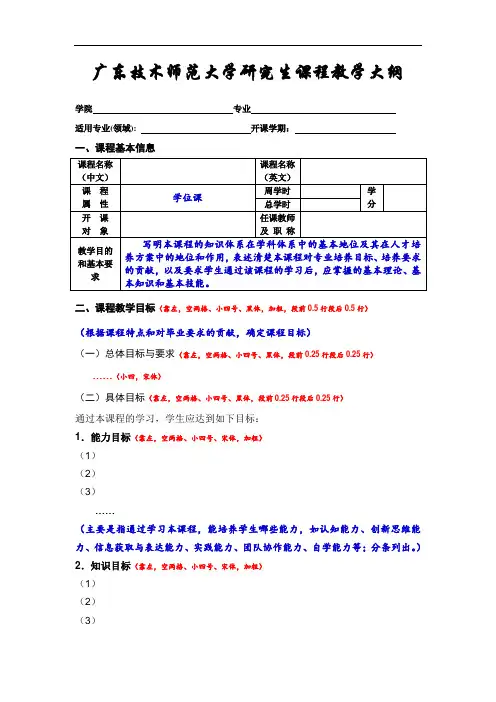
广东技术师范大学研究生课程教学大纲学院专业适用专业(领域): 开课学期:一、课程基本信息二、课程教学目标(靠左,空两格、小四号、黑体,加粗,段前0.5行段后0.5行)(根据课程特点和对毕业要求的贡献,确定课程目标)(一)总体目标与要求(靠左,空两格、小四号、黑体,段前0.25行段后0.25行)……(小四,宋体)(二)具体目标(靠左,空两格、小四号、黑体,段前0.25行段后0.25行)通过本课程的学习,学生应达到如下目标:1.能力目标(靠左,空两格、小四号、宋体,加粗)(1)(2)(3)……(主要是指通过学习本课程,能培养学生哪些能力,如认知能力、创新思维能力、信息获取与表达能力、实践能力、团队协作能力、自学能力等;分条列出。
)2.知识目标(靠左,空两格、小四号、宋体,加粗)(1)(2)(3)……(简要介绍学生应掌握课程的主要知识点,分条列出)3.素质目标(靠左,空两格、小四号、宋体,加粗)(1)(2)(3)……(主要是指通过学习本课程,能培养学生具备哪些方面的素质,分条列出)三、课程主要内容及学时分配第X章XXXXXX(靠左,小四号、黑体,加粗,段前0.5行段后0.5行)[教学主要内容](靠左,五号、黑体,加粗,段前0.5行段后0.5行)一、教育研究的定义(靠左,空两格、五号、宋体,段前0.5行段后0.5行)[主要知识点](靠左,五号、黑体,加粗,段前0.5行段后0.5行)[重点及难点](靠左,五号、黑体,加粗,段前0.5行段后0.5行)……四、教学进度安排(靠左,空两格、小四号、黑体,加粗,段前0.5行段后0.5行)(教学环节设计应体现现代教学方法改革。
主要包括课堂讲授、案例教学、研讨课、实验、上机、考试等。
)五、教学方式(靠左,空两格、小四号、黑体,加粗,段前0.5行段后0.5行)(写明本课程教学所采用的教学方式。
教学方式应该多样化,且须分别对应于课程教学目标中的知识目标、能力目标及素质目标等。
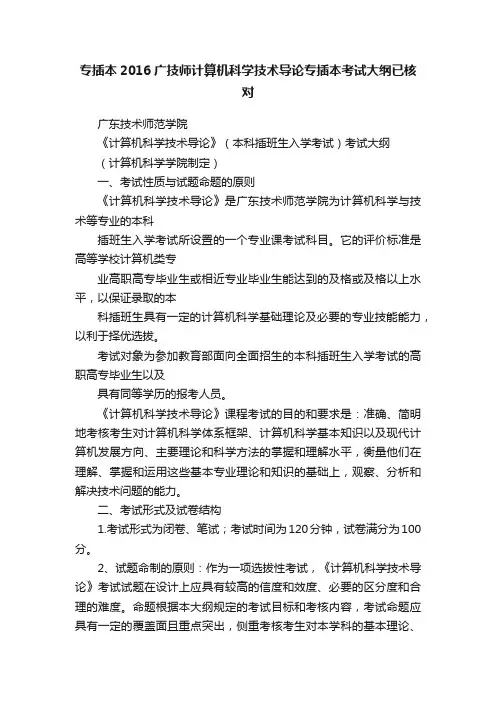
专插本2016广技师计算机科学技术导论专插本考试大纲已核对广东技术师范学院《计算机科学技术导论》(本科插班生入学考试)考试大纲(计算机科学学院制定)一、考试性质与试题命题的原则《计算机科学技术导论》是广东技术师范学院为计算机科学与技术等专业的本科插班生入学考试所设置的一个专业课考试科目。
它的评价标准是高等学校计算机类专业高职高专毕业生或相近专业毕业生能达到的及格或及格以上水平,以保证录取的本科插班生具有一定的计算机科学基础理论及必要的专业技能能力,以利于择优选拔。
考试对象为参加教育部面向全面招生的本科插班生入学考试的高职高专毕业生以及具有同等学历的报考人员。
《计算机科学技术导论》课程考试的目的和要求是:准确、简明地考核考生对计算机科学体系框架、计算机科学基本知识以及现代计算机发展方向、主要理论和科学方法的掌握和理解水平,衡量他们在理解、掌握和运用这些基本专业理论和知识的基础上,观察、分析和解决技术问题的能力。
二、考试形式及试卷结构1.考试形式为闭卷、笔试;考试时间为120分钟,试卷满分为100分。
2、试题命制的原则:作为一项选拔性考试,《计算机科学技术导论》考试试题在设计上应具有较高的信度和效度、必要的区分度和合理的难度。
命题根据本大纲规定的考试目标和考核内容,考试命题应具有一定的覆盖面且重点突出,侧重考核考生对本学科的基本理论、基本知识和基本技能的掌握程度,以及运用所学的知识解决实际问题的能力。
3.试题对不同能力层次要求的分数比例:识记25%、理解55%,综合应用15%,其他5%。
4.合理安排试题的难度结构。
试题难易度分为易、较易、较难、难四个等级。
试卷中难易度试题的分布比例,易约占25%,较易约占35%,较难约占20%,难约占10%。
5.试卷的题型有:单项选择题、多项选择题、简答题、改错题、计算题、填空题、综合题等。
可根据考核要求,适当安排各种题型数量的比例,达到考核对知识点的识记、理解以及运用水平和能力。
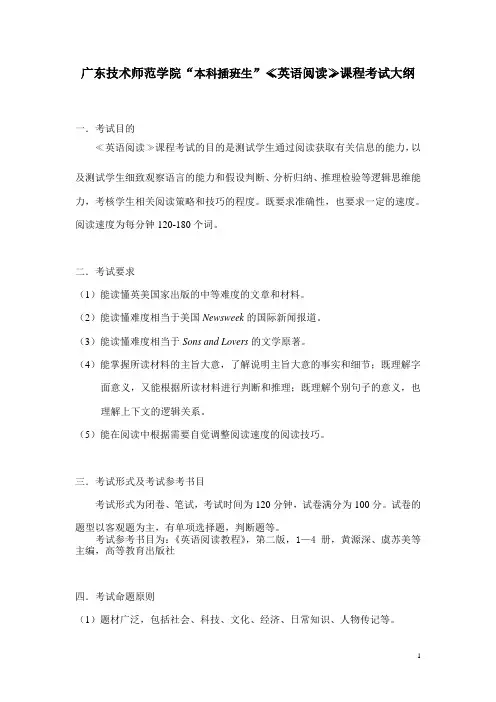
广东技术师范学院“本科插班生”≪英语阅读≫课程考试大纲一.考试目的≪英语阅读≫课程考试的目的是测试学生通过阅读获取有关信息的能力,以及测试学生细致观察语言的能力和假设判断、分析归纳、推理检验等逻辑思维能力,考核学生相关阅读策略和技巧的程度。
既要求准确性,也要求一定的速度。
阅读速度为每分钟120-180个词。
二.考试要求(1)能读懂英美国家出版的中等难度的文章和材料。
(2)能读懂难度相当于美国Newsweek的国际新闻报道。
(3)能读懂难度相当于Sons and Lovers的文学原著。
(4)能掌握所读材料的主旨大意,了解说明主旨大意的事实和细节;既理解字面意义,又能根据所读材料进行判断和推理;既理解个别句子的意义,也理解上下文的逻辑关系。
(5)能在阅读中根据需要自觉调整阅读速度的阅读技巧。
三.考试形式及考试参考书目考试形式为闭卷、笔试,考试时间为120分钟,试卷满分为100分。
试卷的题型以客观题为主,有单项选择题,判断题等。
考试参考书目为:《英语阅读教程》,第二版,1—4册,黄源深、虞苏美等主编,高等教育出版社四.考试命题原则(1)题材广泛,包括社会、科技、文化、经济、日常知识、人物传记等。
(2)体裁多样,包括记叙文、描写文、说明文、议论文、广告、说明书、图表等。
(3)试题难易度分为易、较易、较难、难四个等级。
试卷中四种难易度试题的分数比例,易约占20%,较易约占30%,较难约占30%,难约占20%。
(4)试题中关键词汇基本上不超出≪高等学校英语专业英语教学大纲≫规定的范围。
五.考试样题I. V ocabularyDirections: In each sentence, a word or phrase is underlined. Below each sentence are four other words or phrases. You are to choose the one word or phrase which would best keep the meaning of the original sentence if it were substituted for the underlined word.1. If he insists upon being stubborn, we will have to settle this in court.A. obstinateB. indignantC. abjectD. gauche2. She did not hear what you said because she was completely engrossed in herreading.A. disguisedB. absorbedC. suspendedD. refined3. He was an exemplary prisoner despite his past experience.A. modelB. sampleC. honestD. humble4. She always gets upset about unimportant matters.A. trenchantB. stuntedC. trivialD. prevalent5. As both a religion and a social force, Puritanism has had a widespread influence inthe United States.A. a disturbingB. a complexC. an annoyingD. a far-reaching6. The Constitution guarantees that private homes will not be searched with a writtenauthorization.A. receiptB. warrantC. prescriptionD. accomplice7. His former employer recommended him highly as having been a very industriousworker.A. affluentB. cogentC. diligentD. extinct8. Deems Taylor was distinguished both as a music critic and a composer.A. inventiveB. classifiedC. differentD. eminent9. Many news organizations feel a responsibility to safeguard the rights of citizens.A. protectB. defineC. examineD. challenge10. As nineteenth-century American cultural aspirations expanded, women steppedinto a new role as interpreters of art, both by writing works on art history and byteaching art.A. patronageB. imaginationC. ambitionsD. opportunities11. He cannot be in the dormitory now. I saw him heading for the library a fewminutes ago.A. walking forB. making forC. going forD. leaving for12. New towns are springing up to house the ever-increasing population in this country.A. establishingB. inventingC. generatingD. increasing13. The crowd swelled until the noise made could be heard for miles.A. shoutedB. cheeredC. grewD. scattered14. He was such a shrewd businessman that he never lost money in any transaction.A. fortunateB. cleverC. wealthyD. well-liked15. The indecisive man was readily persuaded to change his mind again.A. easilyB. hardlyC. subtlyD. abruptly16. The indecisive man was readily persuaded to change his mind again.A. easilyB. hardlyC. subtlyD. abruptly17. The two companies are going to merge by the first of the year.A. become oneB. divide into twoC. dissolveD. change owners18. The winning team of the World Series often has a jovial attitude.A. merryB. sadC. somberD. laborious19. He tramped across the cream-colored carpet, leaving a trail of mud behind him.A. limpedB. skippedC. walked unsteadilyD. walked heavily20. The world leaders had a chat early this morning at United Nations headquarters.A. friendly, unimportant talkB. disagreementC. serious discussionD. high-level conference21. I decided to go to the party on the spur of the moment.A. after careful thoughtB. for only a short timeC. without previous thoughtD. at the earliest possible moment22. The theory that business could operate totally without the aid of government hasproved to be an erroneous belief.A. authentic conceptB. argumentC. illusionD. asset23. The clerk had been insolent to his superior once too often; now he was without ajob.A. affectionateB. slyC. dishonestD. rude24. The mother soothed the disappointed child and then promised to take him on apicnic as soon as it stopped raining.A. huggedB. comfortedC. whippedD. praised25. Samuel Morse’s painting ability has been obscured by his other accomplishments.A. revealedB. popularizedC. exposedD. hiddenII. Reading comprehension.Directions: Read the following passages and then choose the best answer for eachitem.Passage OneIn 1892 the Sierra Club was formed. In 1908 an area of coastal redwood trees north of San Francisco was established as Muir Woods National Monument. In the Sierra Nevada mountains, a walking trail from Yosemite Valley to Mount Whitney was dedicated in 1938. It is called John Muir Trail.John Muir was born in 1838 in Scotland. His family name means 搈oor,?which is a meadow full of flowers and animals. John loved nature from the time he was small. He also liked to climb rocky cliffs and walls.When John was eleven, his family moved to the United States and settled in Wisconsin. John was good with tools and soon became an inventor. He first invented a model of a sawmill. Later he invented an alarm clock that would cause the sleeping person to be tipped out of bed when the timer sounded.Muir left home at an early age. He took a thousand-mile walk south to the Gulf of Mexico in 1867and 1868. Then he sailed for San Francisco. The city was too noisy and crowded for Muir, so he headed inland for the Sierra Nevadas.When Muir discovered the Yosemite Valley in the Sierra Nevadas, it was as if he had come home. He loved the mountains, the wildlife, and the trees. He climbed the mountains and even climbed trees during thunderstorms in order to get closer to the wind. He put forth the theory in the late 1860s that the Yosemite Valley had been formed through the action of glaciers. People ridiculed him. Not until 1930 was Muir’s theory proven correct.Muir began to write articles about the Yosemite Valley to tell readers about its beauty. His writing also warned people that Yosemite was in danger from timber mining and sheep ranching interests. In 1901 Theodore Roosevelt became president of the United States. He was interested in conservation. Muir took the president through Yosemite, and Roosevelt helped get legislation passed to create Yosemite National Park in 1906.Although Muir won many conservation battles, he lost a major one. He fought to save the Hetch Valley, which people wanted to dam in order to provide water for San Francisco. In the late 1913 a bill was signed to dam the valley. Muir died in 1914. Some people say losing the fight to protect the valley killed Muir.1. What happened first?A. The Muir family moved to the United States.B. Muir Woods was created.C. John Muir learned to climb rocky cliffs.D. John Muir walked to the Gulf of Mexico.E. Muir visited along the east coast.2. What did John Muir do soon after he arrived in San Francisco?A. He ran outside during an earthquake.B. He put forth a theory about how Yosemite was formed.C. He headed inland for the Sierra Nevadas.D. He began to write articles about the Sierra Nevadas.E. He wrote short stories for the local newspaper.3. When did John Muir meet Theodore Roosevelt?A. between 1901 and 1906B. between 1838 and 1868C. between 1906 and 1914D. between 1868 and 1901E. between 1906-19074. What happened last?A. John Muir died.B. John Muir Trail was dedicated.C. Muir’s glacial theory was proven.D. The Sierra Club was formed.E. John’s family visited him.Passage TwoWhen using a metal file, always remember to bear down on the forward stroke only. On the return stroke, lift the file clear of the surface to avoid dulling the instrument’s teeth. Only when working on very soft metals is it advisable to drag the file’s teeth slightly on the return stroke. This helps clear out metal pieces from between the teeth.It is best to bear down just hard enough to keep the file cutting at all times. Too little pressure uses only the tips of the teeth; too much pressure can chip the teeth. Move the file in straight lines across the surface. Use a vice to grip the work so that your hands are free to hold the file. Protect your hands by equipping the file with a handle. Buy a wooden handle and install it by inserting the pointed end of the file into the handle hole.1. These directions show you how to-A. work with a hammerB. use a fileC. polish a fileD. oil a viseE. repair shop tools2. When using a file-A. always bear down on the return strokeB. move it in a circleC. remove the handleD. press down on the forward strokeE. wear protective gloves3. When working on soft metals, you can-A. remove the handleB. clear metal pieces from the teethC. bear down very hard on the return strokeD. file in circlesE. strengthen them with added wood4. Protect your hands by-A. dulling the teethB. dragging the teeth on the backstrokeC. using a viseD. installing a handleE. wearing safety glovesPassage ThreeInsects’ lives are very short and they have many enemies, but they must survive long enough to breed and perpetuate their king. The less insectlike they look, the better their chance of survival. To look “inedible” by resembling or imitating plants or objects that hold no interest for their enemies is a deception widely practiced by insects. Mammals rarely use this type of camouflage, but many fish and invertebrates do.The stick caterpillar is well named. It is hardly distinguishable from a brown or green twig. This caterpillar is quite common and can be found almost anywhere in North America. It is also called “measuring worm” or “inchworm”. It walks by arching its body, then stretching out and grasping the branch with its front feet, then looping its body again to bring the hind feet forward. When danger threatens, the stick caterpillar stretches its body away from the branch at an angle and remains rigid and still, like a twig, until the danger has passed.Walkingsticks, or stick insects, do not have to assume a rigid, twiglike pose to find protection; they look like inedible twigs in any position. There are many kinds of walkingsticks, ranging in size from the few inches of the North American variety to some tropical species that may be over a foot long. When at rest their front legs are stretched out, heightening their camouflage. Some of the tropical species are adorned with spines or ridges, imitating the thorny bushes or trees in which they live.Leaves also seem to be a favorite object for insects to imitate. Many butterflies can suddenly disappear from view by folding their wings and sitting quietly among the foliage that they resemble.1. What is the main subject of the passage?A. Caterpillars that live in trees.B. The feeding habits of insects.C. How some insects camouflage themselves.D. Insects that are threatened with extinction.2. According to the passage, how does the stick caterpillar make itself look like a twig?A. By holding its body stiff and motionless.B. By looping itself around a stick.C. By changing the color of its skin.D. By laying its body flat against a branch.3. Which of the following is true of stick insects?A. They resemble their surroundings all the time.B. They make themselves look like other insects.C. They are camouflaged only when walking.D. They change color to make themselves invisible.4. Which of the following are NOT mentioned in the passage as objects that are imitated as a means of protection?A. thornsB. FlowersC. LeavesD. Sticks Passage FourThe nuclear age in which the human race is living, and may soon be dying, began for the general public with the dropping of an atom bomb on Hiroshima on 6 August 1945. But for nuclear scientists and for certain American Authorities, it had been known for some time that such a weapon was possible. Work towards making it had been begun by the United States, Canada and Britain very soon after the beginning of the Second World War. The existence of possibly explosive forces in the nuclei of atoms had been known every since the structure of atoms was discovered by Rutherford.An atom consists of a tiny core called the “nucleus” with electrons circling round it. The hydrogen atom, which is the simplest and lightest, has only one electron. Heavier atoms have more and more as they go up the scale. The first discovery that had to do with what goes on in nuclei was radioactivity, which is caused by particles being short out of the nucleus. It was known that a great deal of energy is locked up in the nucleus, but, until just before the outbreak of the Second World War, there was no way of releasing this energy in any large quantity. A revolutionary discovery was that, in certain circumstances, mass can be transformed into energy in accordance with Einstein’s formula which states that the energy generated is equal to the mass lost multiplied by the square of the velocity of light.The A-bomb, however, used a different process, depending upon radioactivity. In this process, called “fission”, a heavier atom splits into two lighter atoms.In general, in radioactive substances this fission proceeds at a constant rate which is slow where substances occurring in nature are concerned. But there is one form of uranium called “U235” which, when it is pure, sets up a chain reaction which spread s like fire, though with enormously greater rapidity. It is this substance which was used in making the atom bomb.The political background of the atomic scientists’ work was the determination to defeat the Nazis. It was held—I think rightly—that a Nazi victory would be a terrible disaster. It was also held, in Western countries, that German scientists must be well advanced towards making an A-bomb, and that if they succeeded before the West did they would probably win the war. When the war was over, it was discovered, to the complete astonishment of both American and British scientists, that the Germans were nowhere near success, and, as everybody knows, the Germans were defeated before any nuclear weapons had been made. But I do not think that nuclear scientists of the West can be blamed for thinking the work urgent and necessary. Even Einstein favored it.When, however, the German war was finished, the great majority of those scientists who had collaborated towards making the A-bomb considered that it should not be used against the Japanese, who were already on the verge of defeat and who, inany case, did not constitute as great a threat to the world as Hitler did. Many of them made urgent representations to the American Government maintaining that, instead of using the bomb as a weapon of War they should after a public announcement, explode it in a desert, and that future control of nuclear energy should be placed in the hands of an international authority. Seven of the most famous nuclear scientists drew up what is known as “The Frank Report” which they presented to the Secretary of War in June 1945. The is a very admirable and far-seeing document, and if it had won the agreement of the politicians, none of our subsequent terrors would have arisen.1. We may conclude that the writer’s attitude towards the A-bomb is that _______.A. it is a necessary evilB. it is a terrible threat to the whole of mankindC. it played a vital part in defeating the JapaneseD. it was a wonderful invention2. According to the passage, an atom is heavy if _______.A. it has a large nucleusB. it is radioactiveC. its nucleus has many electronsD. its nucleus shoots out many particles3. The American and British scientists were astonished at the end of the SecondWorld War against Germany because _______.A. The Germans had been defeated without the use of nuclear weaponsB. the Western countries had won before they have invented nuclear weaponsC. they thought the Germans would probably win the warD. the Germans had made little progress in developing nuclear weapons4. According to the writer, most scientists who had helped in making the A-bomb considered that it should not be used against the Japanese because ________.A. it was such a dangerous weaponB. its use against the Japanese was unnecessaryC. it was very inhumane weaponD. the German war was finished Passage FiveMy Mother Who Came from China Where She Never Saw SnowLaureen MarIn the huge, rectangular room, the ceilinga machinery of pipes and fluorescent lights,ten rows of women hunch over machines,their knees pressing against pedalsand hands pushing the shiny fabric thick as tongues 5through metal and thread.My mother bends her head to one of these machines.Her hair is coarse and wiry, black as burnt scrub.She wears glasses to shield her intense eyes.A cone of orange thread spins. Around her, 10talk flutters harshly in Toisan wah.Chemical stings. She pushes cloththrough a pounding needle, under, around, and out,breaks thread with a snap against fingerbone, tooth.Sleeve after sleeve, sleeve. 15It is easy. The same piece.For eight or nine hours, sixteen bundles maybe,25- sleeves to ski coats, all the same.It is easy, only once she’s run the needlethrough her hand. She earns money 20by each piece, on a good day,thirty dollars. Twenty-four years.It is frightening how fast she works.She and the women who were taught sewingterms in English as Second Language. 25Dull thunder passes through their fingers.1. The main idea of the poem is to show that _________.A. the woman has led a heroic life of struggleB. women factory workers do not see the opportunity in America for people whoaren’t afraid of a little ha rd workC. a factory worker faces dull, difficult work every dayD. Chinese women are very good at sewing2. The key idea of the line “breaks thread with a snap against fingerbone, tooth” (line14) is that ____________.A. women often broke their teeth or fingers doing this kind of workB. the thread was so brittle that sometimes it simply snapped offC. women often broke the thread with their hands and teethD. women often snapped their fingers to make the day go faster3. We can infer from this poem that the women were taught sewing terms in Englishbecause ____________.A. their employers were Americans with little knowledge of ChineseB. every native speaker of English sews as a hobbyC. these were words the women needed to know on the jobD. both A and C4. When the poet says her mother’s hair was “black as burnt scrub” (line 8) sheprobably means that ____________.A. her hair was often burned by chemicals at workB. her hair was very shortC. her hair was worn tied up to keep it out of the spinning machinesD. her hair was black and stiff and looked like a burned bush.5. From the tone of this poem, what can you conclude about how the poet views theexperience of working in a factory?A. It is challenging work.B. It is always the same.C. It offers a chance for someone to earn a reasonable working wage.D. It enables the women who work there to get better jobs.6. The poet uses the basic technique of letting one day at work stand for workdaysover many years, because ___________.A. this was a special day at workB. this was the mother’s twenty-fourth anniversaryC. one day t work is much like any otherD. one day t work was enough for the daughter7. In the poem, the mood is one of ____________.A. cheerfulnessB. unhappinessC. admirationD.repetition8. The reason that the poet tells us, in the title, that her mother never saw snow is__________.A. to show even more vividly how meaningless is the mother’s job of makingsleeves for jackets used in the snowB. to give some background about China’s geographyC. to prove that it does not snow anywhere in ChinaD. to show how people can miss the beauties of nature9. Figurative expressions in this poem may be found in lines ___________.A. 5, 6, 7 and 8B. 5, 11, 12 and 13C. 1, 3, 4 ad 10D. 2, 5, 8 and2610. When the poet says “it is frightening” in line 23, she means the word frighteningin what sense?A. The mother scares the poet.B. The mother’s ability to stand her job scares the poet.C. The mother looks scary when she works so fast.D. The mother’s work is so dangerous that it scares the poet.11. Which answer best explains the meaning of line 26, “Dull thunder passes throughtheir fingers”?A. The job is dull.B. The women radiate a power like electricity.C. The noise and the vibrations of the machines sound like the rumbling ofthunder.D. all of the above12. Which of the following statements can be safely inferred from the poem?A. The mother hated her job.B. The American bosses resented the women speaking Chinese.C. The machines made a good deal of noise.D. Chinese women enjoy sewing.Passage SixCRIME: AN EVER-GROWNING PROBLEMWhatever you do, wherever you live, you are a victim of crime whether you like it or not, whether you know it or not.Of the many problems in the world today, none is as widespread, or as old, as crime. Crime has many forms, including crimes against property, person, and government. There is even a class of crimes called “crimes without victims” (e.g., prostitution). Crime, in all its forms, penetrates every layer of society and touches every human being. You may never have been robbed, but you suffer the increased cost of store-bought items because of others’ shoplifting, and you pay higher taxes because of others’ tax evasion. Perhaps your house is not worth as much today as it was a few years ago because of the increased crime rate in your neighborhood, or maybe your business is not doing as well as it used to because tourism is down due to increased terrorism in your part of the world. Whatever you do, wherever you live, you are a victim of crime whether you like it or not, whether you know it or not.Crime, especially violent crime, has risen to a point where many people are afraid to walk alone in their own neighborhoods, afraid to open their door after dark, afraid to speak out and voice their own opinions. Some citizens have reacted by arming themselves with various weapons, legal and illegal, to defend themselves. Citizen groups have taken the law into their own hands by forming their own vigilante groups to administer “judgement” when they feel that their criminal justice system has not performed its duty.Experts argue whether the number of crimes committed is actually on the rise or whether there is simply a rise in the number of crimes reported. This issue is particularly true in cases of conjugal violence, the abuse of spouse or children. Throughout much of history, cases of family violence and neglect often went unreported because of the attitude of society, which considered family maters to be private.Other experts argue about who is really to blame for criminal behavior: the individual or society. Researchers in the United States and Canada have identified several factors in society that contribute to the crime rate: massive urbanization, unemployment and poverty, and a large immigrant population. Other countries are more affected by factors such as politics, government corruption, and religion.The most important question that still remains unanswered, however, is how to stop crime from happening. In this chapter, we will look at a number of specific crimes and see what types of solutions are being proposed to combat them. In doing this, we shall see how problems are presented and how solutions are offered.( ) 1. Decide which of the following expresses the main idea.A. Crime has many forms, including crimes against property, person, andgovernment.B. Crime, in all its forms, penetrates every layer of society and touches everyhuman being.C. Everybody is a victim of crime whether he is aware of it or not.D. There is much debate about who is really to blame for criminal behavior. Decide whether the following statements are true (T) or false (F).( ) 2. Everyone is a victim of crime.( ) 3. Your house may lose part of its value as a result of crime.( ) 4. There is indication that the criminal justice systems fails to perform their duties.( ) 5. Experts agree that the crime rate is rising.( ) 6. Many cases of crime want reported.( ) 7. Diversified factors contribute to the crime rate.( ) 8. This passage is an introduction to a detailed discussion of crimes and their solutions.。

附件4广东省中等职业学校专业课教师和实习指导教师资格考试面试大纲一、测试性质面试是中等职业学校专业课教师和实习指导教师资格考试的组成部分,属于标准参照性考试。
笔试科目《专业知识与教学能力》的考察结合面试环节进行。
二、测试目标面试主要考察申请中等职业学校专业课教师和实习指导教师资格人员应具备的新教师基本素养、职业发展潜质、教育教学能力、专业基础知识和基本技能,主要包括:1.良好的职业认知、心理素质和思维品质。
2.较好的专业基础知识,必需的基本技能。
3.仪表仪态得体,有一定的表达、交流、沟通能力。
4.能够恰当地运用教学方法、手段,教学环节规范,较好地达成教学目标。
三、测试内容与要求(一)职业认知1.热爱教育事业,能正确认识、理解中等职业教育专业课教师和实习指导教师的职业特征,遵守教师职业道德规范,能够正确认识、分析和评价教育教学实践中的师德问题。
2.关爱学生、尊重学生,公正平等地对待每一位学生,关注每一位学生的成长。
遵循学生身心发展规律,以学生发展为本,培养学生的职业兴趣、学习兴趣和自信心,激发学生的主动性和创造性,发挥学生特长,挖掘学生潜质,为每一个学生提供适合的教育,提高学生的就业能力、创业能力和终身学习的能力,促进学生健康快乐成长,学有所长,全面发展。
(二)心理素质1.积极、开朗,有自信心。
具有积极向上的精神,主动热情工作;具有坚定顽强的精神,不怕困难。
2.有较强的情绪调节与自控能力。
能够有条不紊地工作,不急不躁;能够冷静处理问题,有应变能力;能公正地看待问题,不偏激,不固执。
(三)仪表仪态1.仪表整洁,符合教育职业和场景要求。
2.举止大方,肢体语言得体,符合教师礼仪和教学内容要求。
(四)言语表达1. 语言清晰,语速适宜,表达准确。
口齿清楚,讲话流利,发音标准,声音洪亮,语速适宜;讲话中心明确,层次分明,表达完整,有感染力。
2. 善于倾听、交流,有亲和力。
具有较强的口头表达能力,善于倾听别人的意见,并能够较准确地表达自己的观点;在交流中尊重对方、态度和蔼。
Self-introduction自我介绍Name:William Shakespeare Graduated University:×××××××××××Major:English Literature Admission Time:20XX-09-01—20XX-06-30Telephone:+86×××××××(MP)E-mail:520521××××@(后附范文5篇及10类常见问题解答,总有一个适合你!)20XX年XX月XX日目录范文一(英文) (3)范文一(中文) (4)范文二(英文) (5)范文二(中文) (6)范文三(英文) (7)范文三(中文) (9)范文四(英文) (10)范文四(中文) (11)范文五(英文) (12)范文五(中文) (16)十类常见问题解答 (17)(一)"What can you tell me about ......?". (18)(二)"What would you like to be doing......?" . (19)(三)"What is your greatest strength ?" (19)(四)"What is your greatest weakness?" (20)(五)"How do you feel about your progress to date?" (21)(六)行为面试问题 (21)(七)压力面试问题 (22)(八)案例面试问题 (22)(九)非常规问题 (23)(十)其他常见的英语面试问题 (24)范文一(英文)--适合医学、理、工、农、艺、政治经济学相关专业Good afternoon dear professors, my name is ××, it is really a great honor to have a chance for this interview.Now I’ll introduce myself briefly. I am ××years old, born in ××province.I received my bachelor degree in 20××, supervised by Professor ××, in ××University.I have been interested in scientific research. In the past few years, I published more than ××(5)papers about numerical methods for the fractional PDE. Furthermore, I am participating in the research of two projects funded by National Natural Science Foundation. At the same time, I undertake a lot of teaching loads, more than ××(200)periods each year.However, with the time going on, the more I studied and experienced, the clearer I realized that I really need study further. Thus, I began to prepare for ××(the doctor’s entrance examination). Owing to my hard work, I passed the first examination. If I am given the chance of further study, I will work hard to enrich my knowledge and make myself to be a well-qualified ××(doctor).I am very easy to get on with, so I have lots of friends. Sometimes I prefer staying alone, reading, surfing the internet to gain some latest news of my profession, also, I’m keen on ××(playing basketball).。
2016年研究生招生专业课考试大纲
硕士专业名称:学科教学·英语教育硕士
考试科目代码及名称:F126英语教学论
Ⅰ考查目标
《英语教学论》属于“学科教学·英语”专业学位硕士研究生入学考试复试笔试科目,要求用英语答题,既考查考生对英语教学简史、英语教学发展趋势以及英语教学的主要流派和方法的了解情况,又检测考生的英语理解和运用能力。
考生不仅需要熟悉英语教学的基本概念和理论,还必须能够运用相关理论指导教学设计,分析和评价教学案例。
Ⅱ试卷题型与分值结构
1.术语解释,20%
2.问答题,20%
3.段落翻译,30%
4.教学案例分析,30%
III.考查内容
Part I Major trends in twentieth-century language teaching20世纪语言教学趋势
1A Brief History of Language Teaching语言教学简史
2The Nature of Approaches and Methods in Language Teaching语言教学法的特点
3The Oral Approach and Situational Language Teaching口语法和情景法
4The Audiolingual Method视听法
Part II Alternative approaches and methods非传统的语言教学方法
5Total Physical Response全身反应法
6The Silent Way沉默法
7Community Language Learning社团语言学习法
8Suggestopedia暗示法
9Whole Language整体语言教学法
10Multiple Intelligences多元智能法
11Neurolinguistic Programming神经语言程序法
12The Lexical Approach词汇法
13Competency—Based Language Teaching能力导向法
Part III Current communicative approaches当前的交际教学流派
14Communicative Language Teaching交际法
15The Natural Approach自然法
16Cooperative Language Learning合作学习法
17Content—Based Instruction内容教学法
18Task—Based Language Teaching任务教学法
19The Post-methods Era后方法时代。